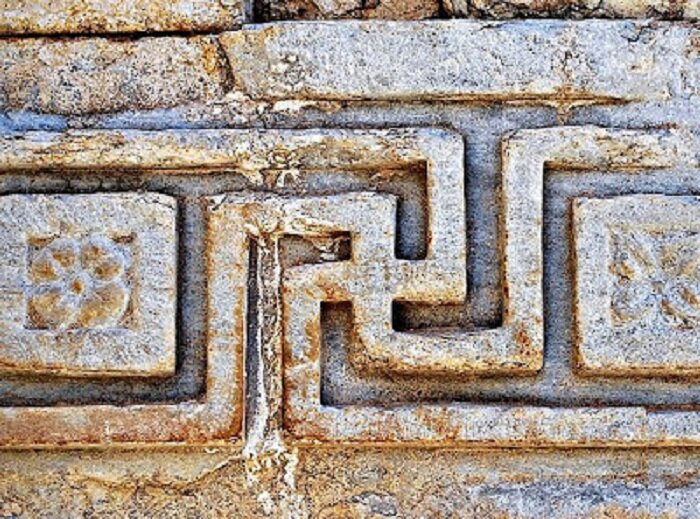Meander
Spiral Meander (Tetragamma or Gammadion)
Symbol of love and the union of opposites. The ordinary mortal Peleas falls in love with the goddess Thetis. Desperate for her love, he presses her into his arms with his handgrip and never lets her go, while the goddess changes forms in rage and resistance: from woman to serpent, to lion, to water, to fire.
Finally, Thetis fell in love with him. A man had tamed her divine part and insisted on his love for her, the goddess used the defenses - tools she had built, but in vain, Peleus' persistent love destroyed them until she was finally exposed in his arms.
The myth, as modern as ever, invites the man of today to summon his masculine nature and all the elements that govern it, to bend the feminine defenses (mainly anger) and conquer the feminine nature in a union of opposing masculine - feminine, mortal - divine, love - hate. Later it was renamed Meander because it was located next to the river of Karia Meander and reminded of the maneuvers of the river.
Eventually, the strong assertion of a man in love symbolized by a hand grip, called Meander, became the most famous and recognizable ancient Greek symbol in the world.
A typical Attic red-figure cup with meander pattern at borders
Lotus Flower
The daughter(Kori) extends her hand and offers a lotus flower to Kouros, and he declares his intention to take it with one step.
This dialog symbolizes the receptive nature of female energy and the action of male energy, the pomegranate symbolizes fertility, love, happiness and bliss shows the exchange of fruit between a couple. The symbol was adopted by several goddesses, Aphrodite to proclaim the fruit of love, Hera to bless the couple's marriage, Athena to show through the pomegranate the fruits of knowledge, Persephone who leaves it as the last fruit before her 6-month descent into Hades (the pomegranate is harvested in September-October).
Detail of the mosaic floor depicting a battle of Greeks and Amazon (Amazonomachy), a panther, palmettes and lotus flowers, East side of the House of the Abduction of Helen, Ancient Pella
Pentagram
Mysia, Pitane, 4th century BC. Horned head of Zeus Ammon right / ΠΙΤΑ; pentagram, leaf in center.
The history of the pentagram shape is long as it goes back to ancient times and we find it in so many historical times and regions, Egypt, Mesopotamia, the Sumerians, the Celts, the seal of King Solomon, the alchemists, Christianity symbolizing the 5 wounds of Christ.
In ancient times it appeared as a symbol of Pythagorean philosophy, which supports the perfection of man by the gods (the 12 gods each had specific qualities, while in mortals all these qualities were inherent), Plato described the pentagram as a "symbol of the sky" : earth, water, fire, air, spirit. Indirect symbol of the goddess Aphrodite, who was recognized as the morning and evening star and proclaimed the perfection of female nature.
More recently, Dr. Carl Jung has pointed out that the number 5 symbolizes completion in our subconscious. So as a symbol of absolute perfection, the pentagram reminds that there can be perfection in nature and therefore in myself, even in moments of completion. As Cornelius Agrippas, one of the most famous alchemists, said, "That which we call quintessence does not come from the four elements, but is the fifth, which maintains its existence above and beyond them."
Spiral
The spiral is a symbol of vital energy, source of life and spiritual power, a shape we encounter very often in nature, indicating the vortex of 2 bodies. It also symbolizes eternal time, the archetype of renewal and proof that everything is connected, time, people, events, stories, coincidences.
Owl
Silver tetradrachm coin at the Museum of Fine Arts of Lyon depicting the owl of Athena (circa 480–420 BC). The inscription "ΑΘΕ" is an abbreviation of ΑΘΗΝΑΙΩΝ, which may be translated as "of the Athenians". In daily use the Athenian drachmas were called glaukes (γλαῦκες, owls). This silver coin was first issued in 479 BC in Athens after the Persians were defeated by the Greeks.
Symbol of wisdom, intelligence and spiritual alertness. The goddess Athena chose the owl as her symbol because she wanted to separate the simple accumulation of knowledge from the profound ability to receive, perceive, connect and use information, and since in ancient Greece it was important how good a warrior one was, the goddess recognized the owl's silent flight in the dark, a virtue that distinguishes a good warrior, to move in the dark without being noticed.
















